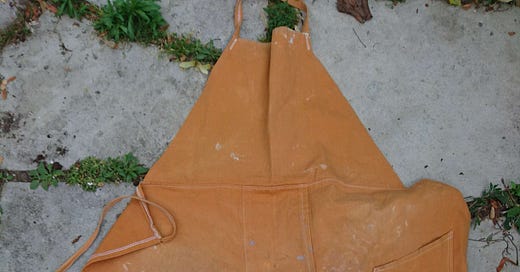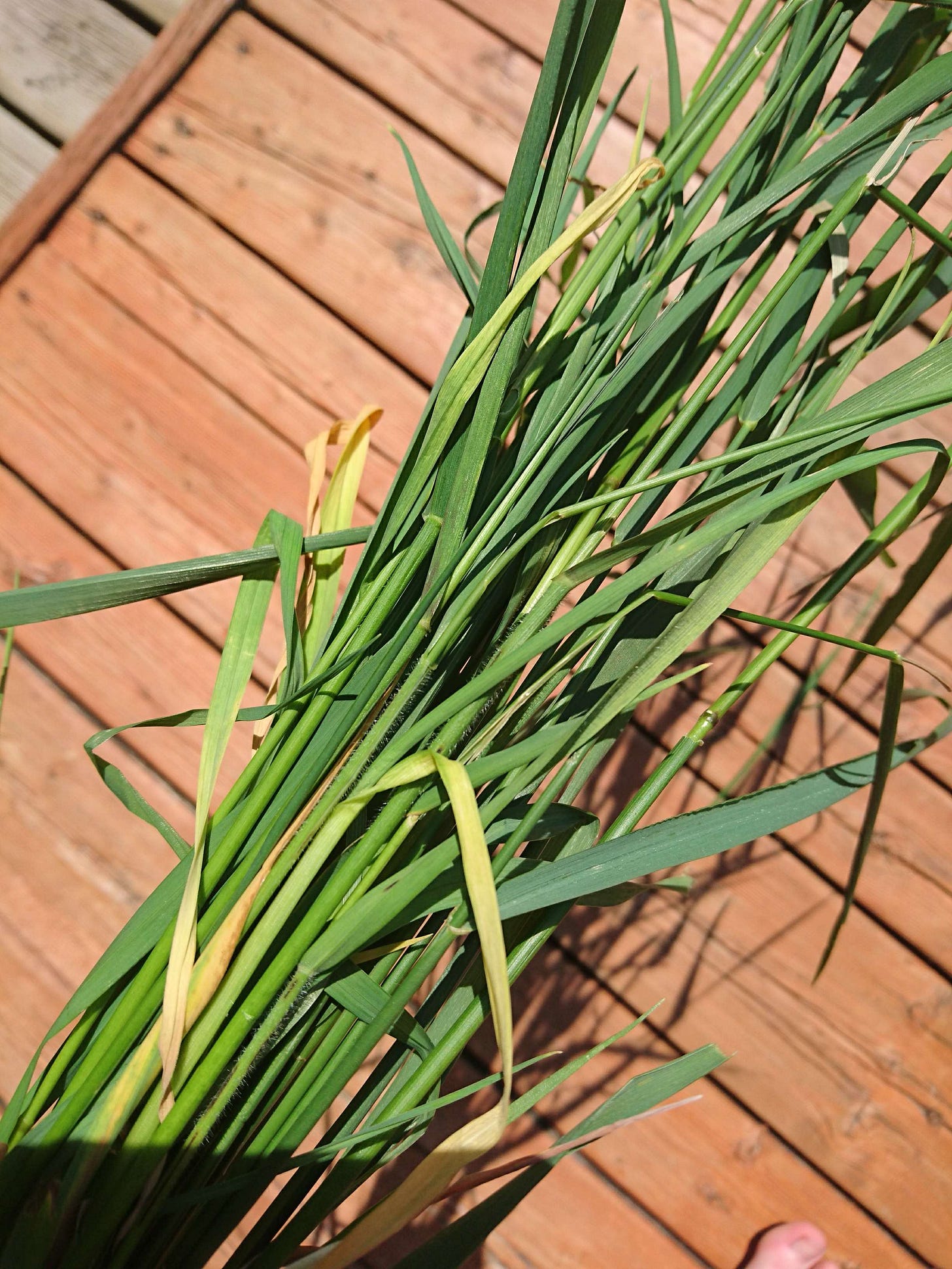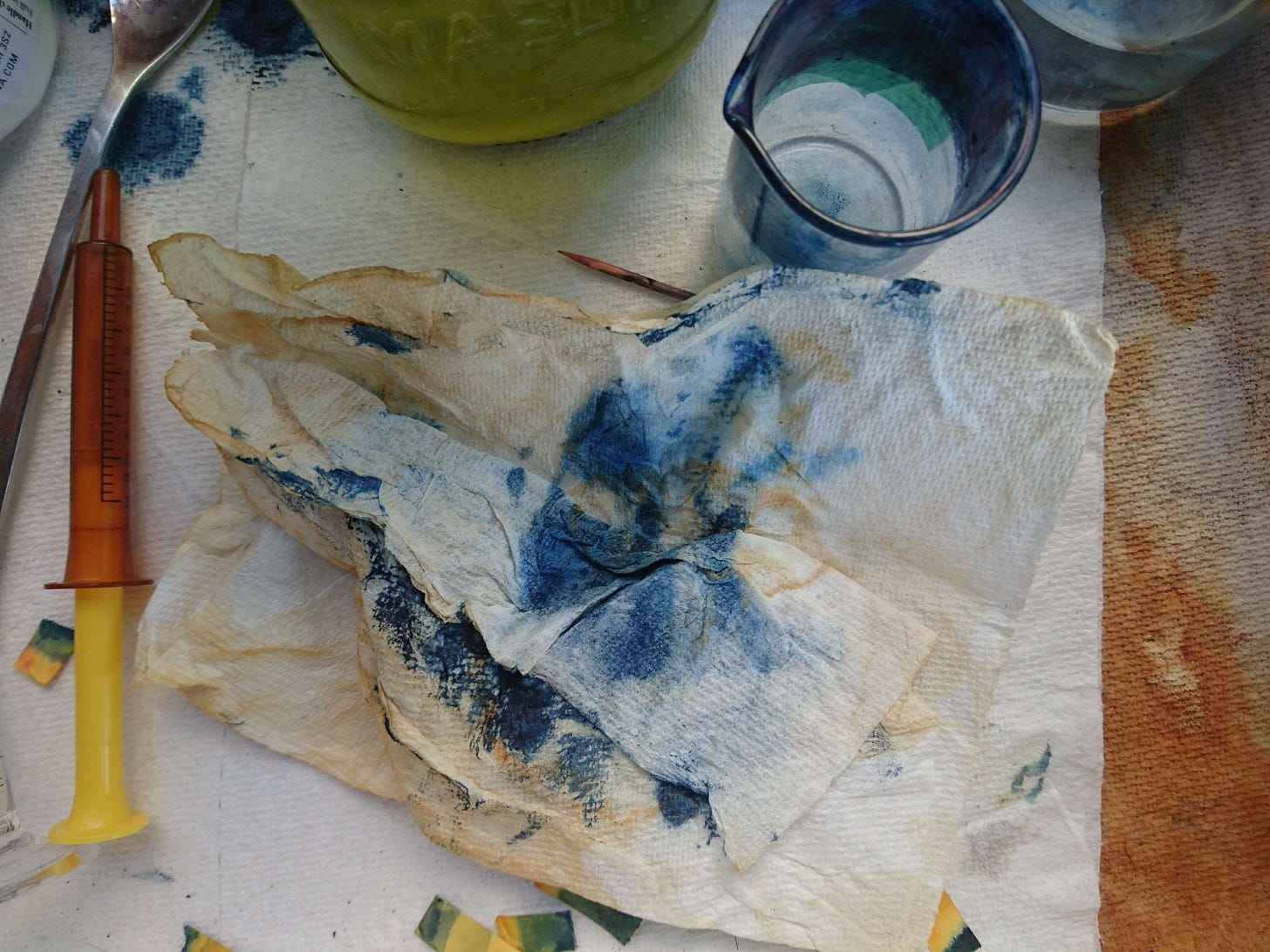Happy Litha,
May your days be bright and your summer adventureous. This solstice, I have assembled a list of commonly encountered materials which may stain your clothes.
It’s a lovely summer day for an adventure. The sun is perfect, brightening the world while not hurting the eyes. A parasol is slung over one shoulder, open and shading the torso. The canopies create dappled patches of sidewalk, covered in the shaded kisses from each leaf. You’re out, about, and having a grand time when plop! You spill something on yourself. What is it? What did you spill it on? What do you do now?
In my experience, most materials can be broken into a few categories: oils/fats, protein, citrus/acid, alkaline, sugar, water, precipitates, and fine particles. Some of them will stain quickly, damage your dyes, or be stubborn about being removed. The categories of this tier list and examples in each will progressively become more difficult to remove from fibres, particularly without a lasting mark or damage to natural fibres.
A quick overview of the tiers
F Tier - generally harmless
E Tier - mostly harmless, sometimes helpful
D Tier - easily dealt with using immediate or delayed techniques
C Tier - can be dealt with using immediate techniques
B Tier - must be dealt with using immediate or tedious techniques
A Tier - must be attended to immediately, potentially not able to remove all traces of the staining material
S Tier - impossible to remove without damaging the fibre or leaving a permanent mark
F Tier
Rain water is probably the least dangerous substance to spill on you clothes. Despite containing a variety of dusts from the sky, it does not have any chemical additives like municipal tap water, nor has it had the opportunity to absorb harsh metals or become ‘hard’ water.
Tap water is next in this tier because of the various minerals and chemicals in the water. While the content varies drastically between sources, it is generally full of soluble materials that can easily be drawn into any fibre and result in stains if not swiftly blotted.
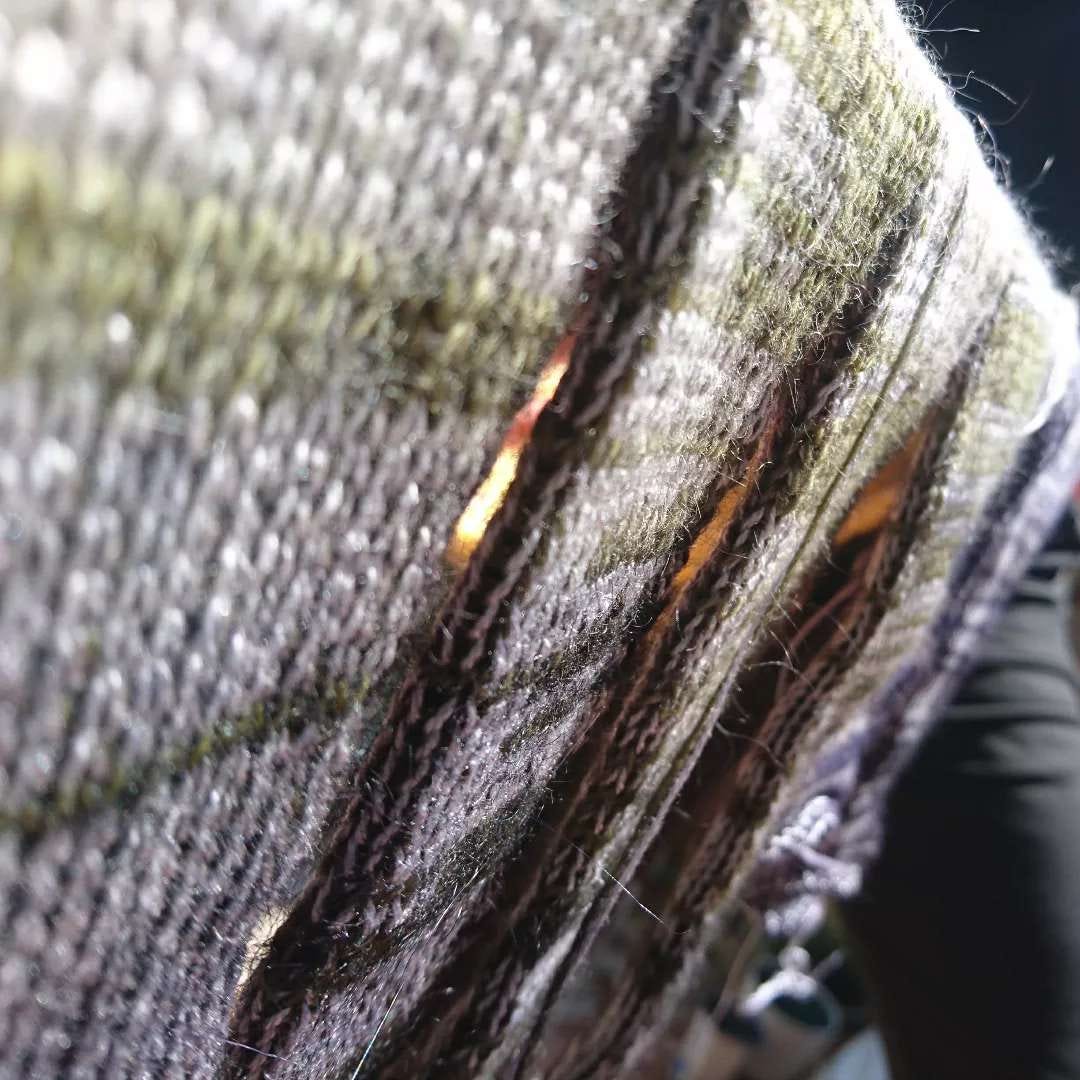
E Tier
For this rank Alcohol refers to high percentage ethanol substance such as rubbing alcohol or vodka. When used properly Vodka can be a deodorizing agent. Generally, the highest concern with vodka is that there will be a water stain. Rubbing alcohol is very concentrated, and can discolour cloth.
Vinegar is often used as a ‘mordant assistant’ in natural dyes, and also used with acid dyes. Wool loves vinegar, and it is excellent for neutralizing soaps. The acetic acid evaporates away, leaving only water to stain the fibres. Like vodka, when used properly it can deodorize and freshen cloth. It can also cause dye colours to bleed as it interferes with the bonds of certain dye chemicals.
Soap is something that we use to regularly clean our fabrics, but there are many different kinds used for our hands, face, clothes, and cars. Some have a neutral pH, carefully cultivated with additives for your skin. Others have abrasive additives, using crushed pumice to scrape away grime (orange pumice soap is amazing for cleaning car grease). If the soap is particularly harsh it can damage the ‘hand’ of the fabric, forever changing the texture of it on your skin.
Soda Ash is another material. Otherwise known as washing soda, it is a powder that is often added to the laundry. It is used as a fixing agent for fibre reactive dyes, and when present can cause those dyes to unbind from their ‘home fibre’ and migrate to another fibre.
D Tier
Citrus, in the form of lemon juice, squeezed limes, and orange slices can damage dyes. The acids themselves can damage the mordant bond in natural dyes. The accompanying sugars can impose an unpleasant texture, and require washing. Citric acid is used with acid dyes, so there is no worry if you know what your clothing was dyed with.
Soluble sugar is another danger, albeit one generally solved by blotting or gently washing the cloth. Dried sugar can form a crust of crystals, or water spots as it changes how the water evaporates. Watch for it in fruit juices, mixed drinks, or wine.
Alcohol beverages in this rank are often mixed drinks, whiskey adjacent beverages, beer, and anything not vodka or wine. These are often laden with sugars, citrus, or a mixture of the two. Whiskey might not a suspect, but the process of breaking down starches creates sugars and alcohol, some of which make it into the final bottling process and thus the drink itself.
Grass stains often make themselves known on light coloured clothing. Luckily grass is a fugitive dye, and despite it’s resistance to soap grass stains cannot fight the sun! Praise the sun! Ahem. That said, using sunlight exposure to accelerate the disintegration of grass stains will also damage other pigments on the cloth. Thankfully grass stains usually appear on white or cream coloured clothing.
Sweat is a solution made of dead skin (protein), salt, oil, bacteria, and water. It is pervasive and accidentally gets on clothing despite the best of intentions. Rinse it promptly, wear clothing with lower or no armpits in the summer, or try wearing darker colours where the stain will not show. A type of shift may also be useful for catching the sweat before it contacts the outer garments.
Clay and glaze are mixtures containing soluble and insoluble materials. Being a potter or entering a pottery studio is accepting that there is a risk of these materials splashing or rubbing onto fabric. Usually the clay and glaze will dry and slake off of clothing without issue. If it contains red iron oxide, then it is considered S tier.
C Tier
Milk is mostly water, and causes issues when it dries. The proteins become caught up in or bond with protein fibres. They can curdle or rot when left unattended. Care for spilled milk must be swift, lest the fibres suffer.
Tea is a delightful, almost quintessential beverage. The classic orange pekoe tea has oodles of tannin dissolved in hot water, floating freely and waiting to bond to protein fibres or be captured inside cellulose. Accompanying the tannin is milk, sugar, or lemon in small amounts.
White wine has fewer tannin than red wine, and is a generally clear beverage. That said, it can have a high concentration of sugars, leading to long lasting if not permanent stains on light coloured fabrics. Couple that with the fact that they are often paired with light summer dishes, and summer dinner parties are paired with light hued summer dresses. White wine can make its mark.
Wax can be removed from most cloth via ironing. The task is tedious and time consuming. It is difficult to remove all of the wax, resulting in a crackle in the fabric. If the wax is coloured then there is a chance that it will leave colours in the fibres, as well.
B Tier
Red wine contains a its own, darker tannin. Often they are used to discuss the flavour profile. This, along with the plentiful sugars, is what puts red wines a step above white and rosé wines.
Often described as the water of life, coffee contains its own type of dark tannin, a deeper hue than tea tannin, and is more plentiful than in tea or wine. It too is often accompanied by milk, and the heat at which it is consumed contributes to the binding of proteins to fibres.
The water of life, “beatha uisce” in Irish (lit. life water), when translated it refers to whiskey.
Most paint used currently are water based or close to water based. The most important part of paint stains is to treat them swiftly, and know the specific type of paint used. Was it water, house paint, oil, linseed oil, wood stain, or lacquer? It’s a pain(t) in the butt. Hehe.
Nail polish needs to be dissolved with acetone, which is a solvent. Those who use it on their fingers are aware that it has a foul odour, and repeated applications are not gentle on the skin; therefore the results of applying acetone on natural fibres is dubious at best.
Other dairy products can cause their own troubles. Cheeses can get mashed into the weave of cloth. Yogourt has much more protein and fats than the mostly water milk. Ice cream also contains delicious fats delicious soothing sugars in a dense form.
Chocolate is a wonderful soothing substance to those of us without a belladona allergy. It contains delicious fats, and tannin which forms part off chocolate’s hue. Chocolate may be mixed with milk, sugar, or fruit bits. Due to these additives, dark chocolate may be the safest chocolate to spill on clothes.
A Tier
During a meal it is common to have meat juice on a plate, and potentially descend from a slice of meat as it is eaten. Unfortunately meat juice is a mixture of proteins and fatty oils, which are delicious but also difficult to remove from clothing. Prompt treatment is a must.
Writing Ink can be a solution made with an aqueous pigment or a precipitated pigment. The trouble comes from inks that are made of fine powder like sumi-e and calligraphy ink sticks. There are inks that contain shellac, which hardens when dry and is what makes many inks waterproof. Certain inks also either contain suspended precipitates or form precipitates in the fibres themselves. Ink that forms a precipitate is S tier.
Printing Ink can be water soluble, and there is a specific child-safe ink that should also be easier to wash out. That said, most printing inks have some manner of oil base. Lithography ink in particular requires a solvent to dissolve. Other types of printing inks are hopefully removeable with soap.
We all know that cat pee is one of the worst materials to get onto clothing. It contains a special set of enzymes, a type of protein, that binds ferociously to any fibre. The purpose of it is to mark territory, which it does excellently. The only thing that I have found that removes cat pee is a skunk odour shampoo. It must be applied immediately, by spot clean or in the wash (or both). Even then, there may be trace amounts remaining that my nose cannot detect. Other forms of animal urine may have a similar effect.
Blood is another troublesome protein. It oxidizes from reds into browns, and binds into fibres. Removal requires soaking in cold water immediately, spot cleaning, then washing. I always have mixed results when removing blood.
Oil can originate from butter, fats, paints, dirty faces. Most of the time spot cleaning with soap will work the material out, but due to its repulsion from water simple on-the-go damp blotting will not remove oil. It must be coaxed out by dry blotting, and then damp soap spot cleaning.
Sewing machine oil or knitting machine oil can be troublesome. Generally the oil is very ‘light,’ which can make cleaning easier; however the knitting machine’s dirty oil is dark. It is full of fine metal particles that are slowly oxidizing from the machine parts as they slide over each other. Old or dirty knitting machine oil is S tier.
Baby Puke is another uncommon yet unsurprising substance. Breast milk is full of beneficial proteins, which will bond to most fibres. Acid from tiny stomachs will assist that process, as well as accelerating the curdling of the milk. Keep your spittle blankets on hand!
S Tier
If Bleach is spilled on clothing unintentionally, then it is about to be a bad day. The high pH of bleach will destroy protein fibres, and will ‘remove’ pigment from fibres. It actually discolours all of the pigment white, and so the dirt etc is still present even after bleach is applied. This is why trying to dye over bleached cloth has mixed results.
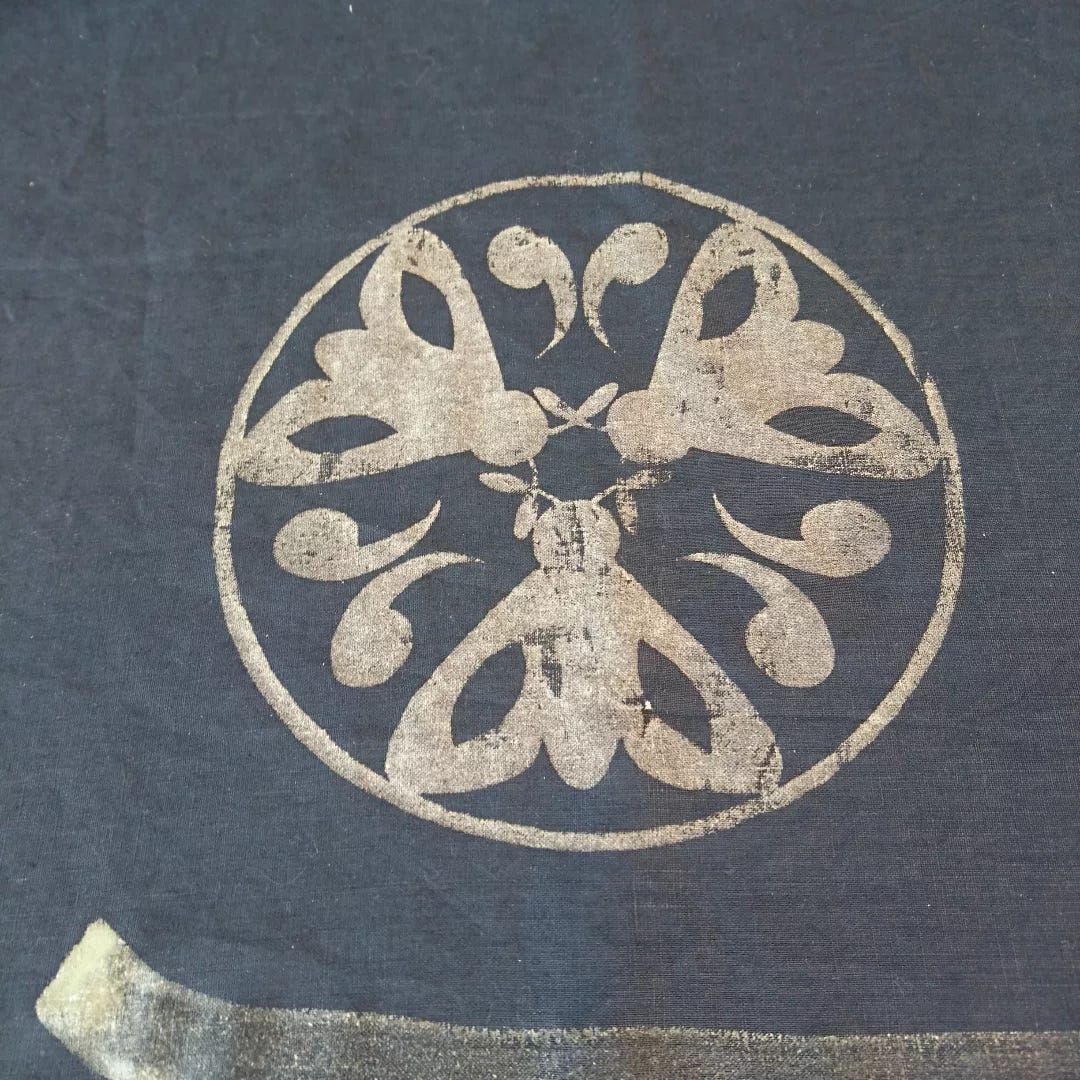
Recall those varieties of soaps mentioned earlier. The variety known as hard soap may be of assistance when dealing with gasoline and solvents. Some solvents may evaporate on their own, although should be given much airflow to do so. They smell like brain damage! While they evaporate, who knows what chemical reactions are occurring with the fibres and dyes.
Rain is a form of precipitation that describes a gas becoming a liquid. The precipitates that I refer to is when a precipitate forms from liquids turning into solids. The most common one that I would think of is salt. Indigo is also a precipitate, which actively forms during the dye process. If drops from the indigo vat splash on clothing it indigo will form inside of the fibre and be difficult to remove. There are also iron-tannin combinations, other materials that create a solid when combined, and if they combine inside of a fibre there is slim chance of removing them and maintaining the integrity of the fibre and dye.
Fine particles have a knack for embedding themselves into fibre and refusing to be released. Red iron oxide is a particular offender from my days in the pottery studio. Oxidized iron is essentially rust, crushed into a smooth powder. The iron oxides would come in yellow, orange, red, and a more granular black iron oxide. Iron is a wonderful material and makes beautiful shades of glaze, but watch the splashes! Once it gets onto a fibre, it ain’t coming out (I have some ideas on potential treatments for other types of iron exposure for clothing, but have not researched this one).
When I asked friends for suggestions one mentioned crude oil. What? How? Certainly a person would have been aware of this upcoming exposure to crude oil. Perhaps a soap or detergent can aid you. Perhaps not. In that case; good-bye fair clothes. RIP.
That is the tier list!
I hope that you enjoyed learning why certain foods and materials stain worse than others. If there is something that you would like to see added to the list please put it in the comments!
